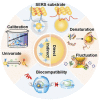Advances in the application of Raman spectroscopy in haematological tumours
- PMID: 36704299
- PMCID: PMC9871369
- DOI: 10.3389/fbioe.2022.1103785
Advances in the application of Raman spectroscopy in haematological tumours
Abstract
Hematologic malignancies are a diverse collection of cancers that affect the blood, bone marrow, and organs. They have a very unpredictable prognosis and recur after treatment. Leukemia, lymphoma, and myeloma are the most prevalent symptoms. Despite advancements in chemotherapy and supportive care, the incidence rate and mortality of patients with hematological malignancies remain high. Additionally, there are issues with the clinical diagnosis because several hematological malignancies lack defined, systematic diagnostic criteria. This work provided an overview of the fundamentals, benefits, and limitations of Raman spectroscopy and its use in hematological cancers. The alterations of trace substances can be recognized using Raman spectroscopy. High sensitivity, non-destructive, quick, real-time, and other attributes define it. Clinicians must promptly identify disorders and keep track of analytes in biological fluids. For instance, surface-enhanced Raman spectroscopy is employed in diagnosing gene mutations in myelodysplastic syndromes due to its high sensitivity and multiple detection benefits. Serum indicators for multiple myeloma have been routinely used for detection. The simultaneous observation of DNA strand modifications and the production of new molecular bonds by tip-enhanced Raman spectroscopy is of tremendous significance for diagnosing lymphoma and multiple myeloma with unidentified diagnostic criteria.
Keywords: Raman spectroscopy; haematological tumours; leukaemia; lymphoma; multiple myeloma; myelodysplastic syndromes.
Copyright © 2023 Liang, Shi, Wang and Zhou.
Conflict of interest statement
The authors declare that the research was conducted in the absence of any commercial or financial relationships that could be construed as a potential conflict of interest.
Figures










References
-
- Amini H., Ban Ž., Ferger M., Lorenzen S., Rauch F., Friedrich A., et al. (2020). Tetracationic Bis-Triarylborane 1, 3-Butadiyne as a combined fluorimetric and Raman probe for simultaneous and selective sensing of various DNA, RNA, and proteins. Chemistry 26, 6017–6028. 10.1002/chem.201905328 - DOI - PMC - PubMed
Publication types
LinkOut - more resources
Full Text Sources

